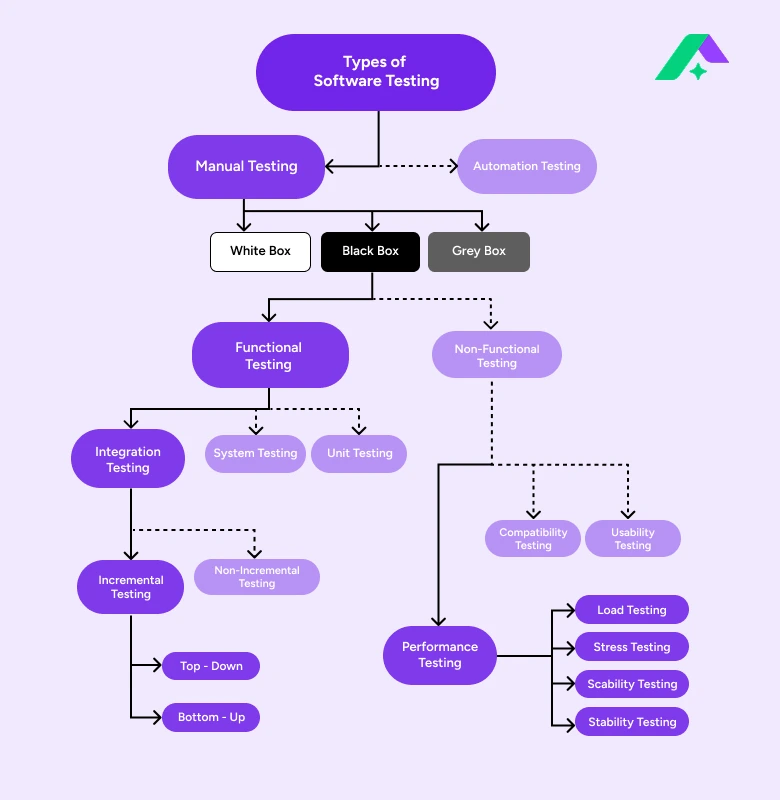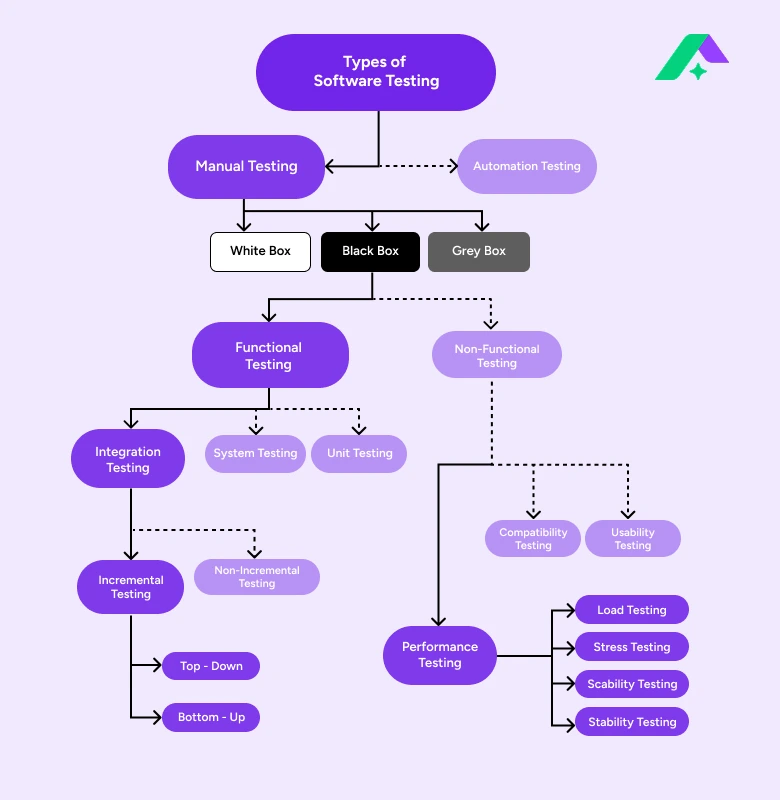Have you ever wondered how the software is built and what goes into creating a fully functional product? We use many products and software daily that have undergone various processes, including testing. Imagine using a product that doesn't work or meet your requirements. It's very frustrating, right? And sometimes, it can turn out to be a disaster. As we increasingly rely on technology, it's crucial to understand why testing a product or software is essential and why going through multiple tests before using it or sharing it with the world is necessary.
As a software tester, I understand the best practices and tools that make software testing effective. Let me take you on this journey, where we’ll delve deeper into software testing, exploring its methods, types, and real-world applications. We will learn what is software testing, and further explore the benefits of software testing and various software testing examples. At the end, I will share with you some Software Testing Courses links which you can consider to grow in this field.
Definition of Software Testing
Do you know what is software testing? Well, Understanding the definition and software testing meaning is essential for ensuring the quality and reliability of a software product. Software testing is a way to assess software quality and reduce the risk of software failure in operation. Software Testing is a part of the Software Development Life Cycle (SDLC). It involves extensive verification and validation of features that utilise various functionalities. Software Testing ensures that the software runs smoothly as expected and has no bugs or glitches.
This also ensures that the software's quality is always high and that performance is not compromised. Every Software build goes through in-depth verification and validation to avoid future problems and minimise risk. The testing helps identify backlogs that need rectification, allowing developers to walk through the cycle repeatedly until a fully functional product is developed that performs as intended. We will learn more about the benefits of software testing in detail in this blog.
Requirements of Software Testing
It's essential to ask why software testing is needed. Why do we test products at all?
When we build a product, we should have certain ideas we want to implement and deliver to the end user. And what if the product is not able to? Many incidents can occur when the product is not adequately tested. There have been many accidents in history where the product was not adequately tested, leading to severe accidents. Here are few, Software testing examples highlight how such oversights can lead to severe consequences.
In 2015, the Bloomberg terminal in London crashed due to a software bug, affecting over 300,000 financial market traders.
Once, Starbucks was compelled to shut down more than 60% of its outlets in Canada and the US due to a software failure in its POS system.
Nissan was forced to recall one million cars from the market due to a software failure in the airbag sensor.
Therefore, testing is crucial. Applications, no matter how big or small, can affect the end user and the entire product-building team.
Even though testing costs money, addressing flaws, poor functionality, or security vulnerabilities associated with software is crucial. Companies can save millions annually by following effective testing techniques and QA processes, and further help concentrate on product growth and development.
Automation Testing Training
Generative AI
Understanding Verification Vs. Validation in Software Testing
Software Testing can be done using two approaches: verification and validation.
Verification is a process of verifying what the product is doing currently and what it is supposed to do or deliver functionally. It's a process of checking if the product is built correctly.
Validation means understanding if the product is built in such a way that it meets the customer's requirements. It's verifying if the right product is built for the right audience. Again, this verification and validation are done by automation and manual methods.
Exploring the Various Types of Software Testing
Now that we understand software testing meaning, it's time to learn about the various software testing methods used in the industry. Here is a hierarchy of the types, which are mainly broken down into Manual Testing and Automation Testing. Let's learn about software testing examples in depth and understand where they are applied.
1. Manual Testing:
Manual Testing is one of the software testing examples. As the term suggests, manual basically means the testing process happens manually without any automation. This process involves QA manually, with the possibility of identifying bugs. QAs follows a written test that carries various unique test scenarios, and wherever the test fails or whenever the product gives false output, the bug is reported.
There are various scenarios where the Application or Product is checked manually.
Consider a web page that takes the user's login ID and password. When the user clicks the submit button, it is supposed to take them to the home page. A QA team can test this manually, and if there is any kind of bug, it can be reported to the developers immediately.
2. Automation Testing:
Automation testing is one of the most widely used software testing examples. As the name suggests, automation automatically tests the software without human intervention. In this case, the tester writes various codes to test individual functionality and uses multiple automation tools to test the software.
Different Types of Manual Testing

There are three types of Manual Testing: White Box, Black Box and Grey Box.
Let's discuss each software testing example individually and understand their differences.
1. White Box Testing
White Box testing is performed internally or at the application's code level. Whenever software is built, many programming codes are written and interconnected to perform certain functions. So, when we talk about internal testing, the tester has access to the source code and uses this knowledge to design test cases that can verify the corrections needed at the code level.
2. Black Box Testing
Black Box Testing is a type of Testing that is not concerned with the internal functioning of the software. The tester is primarily responsible for testing the software from the user's perspective. If the software performs specific functions, the tester is only responsible for checking if the output functions as expected and how users interact with and receive a particular product.
Now that we have learned what Black Box Testing is, let's learn more about its types and explore more software testing examples. Black Box Testing is further divided into two categories: functional testing and non-functional testing.
A. Functional Testing
It checks what the system is supposed to do. This can involve testing the requirements and specifications that the software needs to deliver. It focuses on features, input-output, and user interaction.
Further on, functional testing is of various types through software testing examples. There are three types of functional testing: unit testing, Integration Testing, and System Testing.
1. Unit testing
As the name suggests, unit testing involves testing an individual software unit. This involves careful component testing, typically performed by developers, to ensure that all the components interact in an expected way, which increases the chances of getting expected results.
2. Integration Testing
Integration testing involves analysing how the components coordinate or interact with each other in an environment. If there are any integration-related issues, testers identify the cause and try to resolve it so that the units can work smoothly together.
3. System Testing
System testing is another type of software testing in which the entire software application is tested. This testing can be done or executed once the Unit and integration testing are performed to check the application's final functionality and whether it meets the requirements.
B. Non-Functional Testing
It checks how well the system performs under specific conditions. It covers all the other testing aspects not tested in functional testing, including speed, compatibility, usability, and security testing.
Again, nonfunctional testing is categorised into three types: Performance Testing, Usability Testing, and Compatibility Testing. Let's discuss each one individually.
1. Performance Testing
Performance Testing checks how well the application performs under various conditions. It is done to ensure that the software works as expected, even at a specific workload, and can deliver its functionality. Even if the application works as expected, it's crucial to check the software's performance because a bad user experience might result. During performance testing, factors like speed, scalability, and stability ensure that the performance is not compromised.
2. Usability testing
Usability testing is done keeping the users' views in mind. This testing checks how easy or intuitive it is for the end user to interact with the application. It ensures the application is easy to use and provides a great user experience. Based on user interaction, the product is designed or redesigned, prioritising the users' satisfaction.
3. Compatibility testing
Compatibility testing ensures that the application is compatible with different environments. Once the application is stable and ready to expand, it must be compatible with other hardware, Browsers, Operating systems, and Networks. It's crucial to consider the wide range of audiences, as different users use various platforms today. Users may access your application through Android, IOS, Chrome, Mac, etc.
3. Grey Box Testing
Grey box Testing is another software testing example. It is a mix of White Box and Black Box testing. The testing is done on both internal and surface levels. As discussed above, white box testing will always work on an internal or code level. In Black Box testing, the tester only cares about the product's functional surface level
Software Testing Life Cycle

Software Testing Life Cycle (STLC) is a step or process every application goes through to check if it is bug-free, quality and functionality are always guaranteed, and it meets all the requirements. Each phase in this cycle has its objectives and deliverables. The primary purpose of this testing cycle is to understand and resolve the bug at the initial stage of development.
There are six stages in this cycle. Let's walk through this one by one.
1. Requirement Analysis
At the beginning of this testing cycle, it's vital to understand what needs testing. Testers review the key requirements and identify the missing ones, ensuring they have all the necessary information to perform adequate testing and report findings to the stakeholders.
2. Test Planning
Once the requirement analysis is completed, the second and most crucial step of STLC is test planning. In this stage, the testers identify the objects and scope of testing. It's done to analyse why testing is done. What parts of the software will be tested? A complete test strategy is developed, focusing on techniques, methods, etc. It also identifies and accesses the testing environment, including needed tools, hardware, and software. The team then estimates the time, effort and cost involved in the testing activities. Roles and responsibilities are clearly defined to ensure smooth collaboration. The stakeholders management review the plan once the testing is planned to ensure that everything aligns with project roles before testing begins.
3. TestCase Design
The next step comes with the TestCase Design phase, which focuses on creating detailed test cases that must be followed, any preconditions, the required test data, and the expected results for each scenario. Based on defined test scenarios, the test cases are identified. It's essential to ensure that each step is simple, straightforward and comprehensive, including step-by-step instructions, input data and the expected results. Once everything is created, the test cases will be thoroughly reviewed and updated as needed. Additionally, a Requirement Traceability Matrix (RTM) is developed to ensure that corresponding test cases cover every requirement, helping maintain complete coverage and traceability.
4. Test Environment Setup
The design team needs an environment to implement the planned test cases, such as software, installing servers, etc. This testing environment is similar to the environment the end user or customer would use. The testing manager supervises most testing environments that the developers set up. After carefully setting up the testing environment, quick smoke testing is performed to check readiness.
5. Test Execution
After careful setup of the environment, the actual execution starts. The testers run the test cases and generate reports to understand the application's overall stability. The actual outcomes are evaluated against the expected outcomes, and if any kind of defect is found, it is logged in the defect tracking system. This tracking system includes key details like steps to reproduce the issue, severity, priority, and system logs. Once these bugs are reported, the developers will review and fix them. This testing continues until the bug persists and closes once it reaches acceptance.
6. Test Closure:
The last phase of the Software Testing Life Cycle (STLC) involves finishing all the testing activities once the testing is executed as planned and no defects have been left unresolved. The testing is wrapped once the application has met all the criteria. The main role is to confirm and finalise that the software is ready for release. It's also a process where every detail of the entire testing process is documented and recorded for future reference or audits.
Popular Software Testing Tools and Their Uses
There are several software Testing tools used by testers to check software performance, functionality, and compatibility. Here is a list of a few popular tools that are used by most testers.
1. BrowserStack
BrowserStack is a popular testing tool used for cloud web and mobile testing platforms. These platforms allow the development team to test their applications on demand across different Operating systems and mobile devices. BrowserStack offers live manual testing, automated testing, and visual testing, as well as Percy.
2. Selenium
Selenium offers developers and testers automated testing for Web applications. It checks whether those Web applications can run exceptionally well across different browsers and platforms. Selenium allows developers to create test scripts in various languages, such as PHP, Python, JavaScript, C#, and Perl.
3. Appium
Appium is also an Open-Source automation testing tool used to automate mobile applications on different OS platforms like ios and Android. It is also used to automate the testing of various mobile applications, such as Native, WAP, and Hybrid Applications. Similarly to Selenium, this tool supports various Programming languages used for both mobile OS.
4. Cucumber
Cucumber is a Behaviour Development (BDD) testing framework that enables teams to write automated test cases in plain English using the Gherkin syntax, which uses simple keywords like “Given”, “When”, and “Then”. This helps collaborate among technical and non-technical stakeholders by making the test scenarios more readable. Cucumber helps create executable specifications that define how the application should behave using simple keywords. It helps bridge the communication gap and ensures everyone understands the system's behaviour.
5. Jira
Jira is a great software tool for project management, tracking issues, and bug tracking. It was greatly developed by Atlassian and is used globally by various organisations for various projects. Jira helps with planning, tracking, and managing work. It is often used in testing for logging and tracking bugs, tracking the status of test execution, and managing various test cycles using plugins.
Benefits of Software Testing
Software Testing plays a vital part in the development life cycle. Even the greatest application, which holds the greatest potential, is incomplete without this process. As we have previously learned why software testing is required and about software testing examples, let's now learn what the benefits of software testing are.
1. Ensures Product Quality:
Testing helps verify that the software meets the required standard and functions. It also ensures that it delivers high-quality products, as testing helps identify bugs, and early fixing of them can help mitigate unexpected risks.
2. Early Bug Detection:
Testing helps in the early detection of bugs, which allows the team to save time, cost, and effort that might be required to fix them in later stages.
3. Customer Satisfaction:
Customers are the end users of the products, and serving them with great products leads to winning their trust. Testing helps to find the software's vulnerabilities in very early stages before even delivering the products to the user. It also helps to build the software in such a way that it's user-specific through various testing operations.
4. Ensures Security:
Testing helps discover or identify the software products' loopholes. It allows the team to be aware of risks and be prepared against attackers and data breaches, which can occur in multiple forms.
5. Cost-effective:
Testing the products helps avoid long-term damage. This allows the team to detect possible bugs and eventually causes less or no damage, saving the cost before expanding or scaling the product in the market.
Software testing has many benefits for the industry. It doesn't only make the application bug-free but also helps give confidence to the team working for its success. Developing full-fledged software is not an overnight effort. It takes months and years and many tests and updates throughout the years.
Best Practices of Software Testing
Now that we’ve explored the benefits of software testing, it’s equally important to understand how to execute the process effectively. Below are some proven approaches that can help make your software testing process more structured, reliable, and impactful.
1. Testing Continuously
Once a few initial software components have been implemented, testing whether the current build produces the expected results is essential. It's like building a layer, testing it, and then building another layer on top of it after successful testing. This mitigates the risk that a giant bug can build up if not resolved early. Therefore, automated testing plays a significant role here, enabling rapid feedback and better detection of defects, thereby improving the quality of the product.
2. Using Automation Tools
For small projects, testing can be done using manual testing methods and HOC testing, but when it comes to Large applications, it might not suffice and needs a huge amount of testing done at every stage, so automated testing fits perfectly into these kinds of large and complex applications. Automated tools allow teams to simulate various scenarios, accelerate test execution, and improve accuracy. Some large-scale organizations might build their in-house tools, whereas others may rely on the vendor or existing testing and tracking solutions.
3. Comprehensive Testing Scope
Effective testing should be done at all levels, including API, UI, system integration, etc. The earlier we perform the automation testing from the surface to the deeper level of the application, the more reliable and stable the software product will be.
4. Configuration Management
Organizing all test assets such as test scripts, results, requirements, and documentation in a centralized system is crucial. Effective configuration management helps teams ensure they are working with the correct builds, encourages better collaboration, and aids in meeting compliance standards with tools like access controls and audit tracking.
5. Involvement of the User with feedback
When we involve users or stakeholders during the testing process, the application is in the right hands for testing, and the product interacts with the world it's being built for. This is where the application is tested to meet real-world requirements, helping developers get quick feedback and develop a more customer-centric perspective to build a great product.
6. Practice Regression Testing
Regression testing should never be skipped as it's a very vital step to follow. It verifies that the new code that has been written hasn't broken the existing functionality. Its a critical step in maintaining overall application stability.
Final Thoughts
There is still scope for errors and improvements in software technologies. There are various ways that the software can be helpful or a troublemaker, as building software ideas comes with its risks. As there are great ways to implement and test software, it's crucial to handle them in every step of implementation, as it can be challenging to identify the bugs in bulk at the end, and it might be a complex part to handle. Now that you know what is software testing and various types of software testing examples, you might be interested in expanding and excelling in this field, as there are lots of great developers and testers required in this world. You can consider various courses on software testing to grow your industry-level knowledge or upskill yourself, as the benefits of software testing are endless. Join Software Testing Course For more topics to learn. and also learn abou the Software Testing Course Syllabus.










